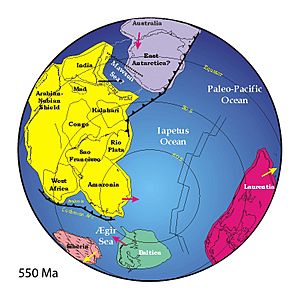Precambrian facts for kids
The Precambrian is a super long stretch of time in Earth's history. It includes all the time before the Cambrian Period, which is when many animals with hard shells first appeared. This amazing period lasted from when Earth began, about 4.567 billion years ago, until about 542 million years ago. That's about 88% of Earth's entire existence!
The name "Precambrian" comes from the Roman name for Wales (Cymru), because scientists first studied rocks from this ancient time there. You might also see it shortened to pC or Cryptozoic.
Contents
What Was the Precambrian?
The Precambrian isn't just one specific time period, like the Jurassic Period with its dinosaurs. Instead, it's a huge umbrella term for almost all of Earth's history, from its very beginning (around 4.6 billion years ago) until the start of the Cambrian Period (about 538.8 million years ago).
Scientists divide this enormous span of time into three main parts, called eons:
- Hadean Eon (4.567 billion to 4.031 billion years ago): This was Earth's earliest, hottest, and most violent time. Imagine a newborn planet with lots of volcanoes and space rocks crashing into it!
- Archean Eon (4.031 billion to 2.5 billion years ago): Things started to cool down. The first continents might have begun to form, and incredibly, the very first signs of life appeared!
- Proterozoic Eon (2.5 billion to 538.8 million years ago): This was the longest part of the Precambrian. During this eon, Earth's atmosphere slowly gained more oxygen, and more complex life forms started to evolve.
Why Is It Hard to Study the Precambrian?
Studying the Precambrian is like trying to read a very old, damaged book. Many rocks from this time have been changed by heat and pressure, or worn away by wind and water. A lot of them are also buried deep underground.
Another challenge is that most creatures back then didn't have hard parts like bones or shells. This means there aren't many fossils to find. The fossils we do discover, like stromatolites, can be tricky to understand. Most of what we know about the Precambrian has been found since the 1960s, and scientists are still piecing together its story.
How Did Earth Form?
Scientists believe Earth formed about 4.543 billion years ago from a swirling cloud of dust and rocks around the young Sun. A little later, a huge object, perhaps the size of Mars, might have crashed into Earth. The pieces that flew off from this giant collision are thought to have formed our Moon!
By about 4.433 billion years ago, Earth had a stable outer layer, called a crust. We know this because scientists have found tiny, super-old crystals called zircons in Western Australia. These crystals are about 4.404 billion years old!
What Was Life Like in the Precambrian?
The biggest mystery of the Precambrian is exactly when life first appeared. It's hard to be certain, but clues suggest life might have been around as early as 3.8 billion years ago! Scientists have found carbon in rocks from Greenland that looks like it came from living things.
In Western Australia, tiny fossils of bacteria have been found that are over 3.46 billion years old! For most of the Precambrian, the only life on Earth was bacteria and other tiny single-celled organisms. These organisms lived in the oceans and often formed large, layered mats called stromatolites. Stromatolites are some of the oldest fossils we have!
Around 2.1 billion years ago, more complex life forms might have appeared. These were multicellular organisms, meaning they were made of more than one cell. However, it's difficult to be sure if these very old fossils are truly multicellular.
The oldest fossils that scientists widely agree are complex multicellular organisms come from the Ediacaran Period (635 to 542 million years ago). These soft-bodied creatures, called the Ediacaran biota, are found all over the world.
At the very end of the Precambrian, creatures with hard shells started to appear. This marked the beginning of the Cambrian Period and a huge increase in the variety of life forms, known as the Cambrian explosion. Even though there were no plants or animals on land during the Precambrian, bacteria and other microbes formed mats that covered the land.
How Did Life Start?
One popular idea about how life began is called the RNA world hypothesis. RNA is a molecule similar to DNA. This idea suggests that RNA came before DNA and proteins. During the Hadean Eon, Earth had many hot, watery places where RNA could have formed and copied itself. Scientists have shown that RNA can indeed replicate itself in these kinds of environments, which could have led to the evolution of the first life forms.
Earth's Environment During the Precambrian
It's tricky to know exactly what Earth was like during the Precambrian. Scientists think that the continents moved around a lot, crashing together to form huge landmasses called supercontinents, and then breaking apart again.
One supercontinent called Rodinia formed around 1.13 billion years ago and broke up about 750 million years ago. There were also several ice ages during the Precambrian. One of the most famous is the Sturtian-Varangian glaciation (850 to 635 million years ago). Some scientists even believe this ice age was so severe that the entire Earth was covered in ice! This idea is known as the "Snowball Earth" theory.
The atmosphere of early Earth was very different from today. Most scientists think it was mostly nitrogen, carbon dioxide, and other gases, with very little oxygen. However, some evidence suggests there might have been some oxygen as early as the Archean Eon.
Eventually, life forms that could make their own food using sunlight (like early bacteria) evolved. These organisms started producing oxygen as a waste product. This caused a huge change in Earth's atmosphere, sometimes called the oxygen catastrophe. At first, the oxygen combined with other elements in Earth's crust, like iron. This formed banded iron formations, which are rocks with layers of iron oxides. After all the iron was used up, oxygen started to build up in the atmosphere, leading to the high-oxygen air we breathe today.
How Is the Precambrian Divided?
As we talked about, the Precambrian is divided into three eons:
- Hadean Eon (4.567 billion to 4.031 billion years ago)
- Archean Eon (4.031 billion to 2.5 billion years ago)
- Proterozoic Eon (2.5 billion to 538.8 million years ago)
The Proterozoic Eon is further divided into three eras:
- Paleoproterozoic Era (2.5 billion to 1.6 billion years ago)
- Mesoproterozoic Era (1.6 billion to 1 billion years ago)
- Neoproterozoic Era (1 billion to 538.8 million years ago)
The Neoproterozoic Era includes the Ediacaran Period (635 to 538.8 million years ago), which is when the first complex multicellular organisms appeared.
Precambrian Supercontinents
Earth's giant plates are always moving. This movement causes continents to crash into each other and form huge landmasses called supercontinents. Here are some supercontinents that formed during the Precambrian:
- Vaalbara: Formed about 3.636 billion years ago and broke up around 2.845 to 2.803 billion years ago.
- Kenorland: Formed about 2.72 billion years ago.
- Columbia or Nuna: Formed about 2.1 to 1.8 billion years ago.
- Rodinia: Formed about 1.3 to 0.9 billion years ago.
 In Spanish: Precámbrico para niños
In Spanish: Precámbrico para niños


